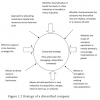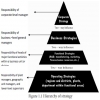Home | ARTS | Strategic Management
|
Mintzberg’s Modes of Strategic Decision-Making - Strategic Management Process
Strategic Management - Concept Of Corporate Strategy
Mintzberg’s Modes of Strategic Decision-Making - Strategic Management Process
Posted On :
Henry Mintzberg has given three most typical approaches of strategic decision making which include:
Mintzberg’s Modes of Strategic Decision-Making
Henry Mintzberg has given three most typical approaches of strategic decision making which include:
1. Entrepreneurial mode
2. Adaptive mode
3. Planning mode
We will
now examine the three modes of strategic decision making.
Strategy is made by one powerful individual who has entrepreneurial competencies like innovation and risk taking. The focus is on opportunities. Problems are secondary. Generally the founder is the entrepreneur and the strategy is guided by his or her own vision of direction and is exemplified by bold decisions.
The success of Biocon India founded by Kiran Mazumdur shaw is an example of this mode of strategic decision making.
Sometimes referred to as “muddling through,” this decision-making mode is characterized by reactive solutions to existing problems, rather than a proactive search for new opportunities. Much bargaining goes on concerning priorities of objectives. Strategy is fragmented and is developed to move the corporation forward incrementally. This mode is typical of most universities, many large hospitals and a large number of governmental agencies.
This decision making mode involves the systematic gathering of appropriate information for situation analysis, the generation of feasible alternative strategies, and the rational selection of the most appropriate strategy. It includes both the proactive search for new opportunities and the reactive solution of existing problems.
Hewlett-Packard (HP) is an example of the planning mode. After a careful study of trends in the computer and communications industries, management noted that the company needed to stop thinking of itself as a collection of stand-alone products with a primary focus on instrumentation and computer hardware. Led by its new CEO, Carly Florina, top management felt that the company needed to become a customer-focused and integrated provider of information appliances, highly reliable information technology infrastructure and electronic commerce service.
A fourth mode of ‘logical incrementalism’ was later added by Quinn.
In this mode, top management first develops reasonably clear idea of the corportion’s mission and objectives. Then, in its development of strategies, it chooses to use “an interactive process in which the organization probes the future, experiments and learns from a series of partial (incremental) commitments rather than through global formulations of total strategies”. Thus the strategy is allowed to emerge out of debate, discussion, and experimentation. This approach appears to be useful when
1. The environment is changing rapidly,
2. It is important to build consensus, and
Henry Mintzberg has given three most typical approaches of strategic decision making which include:
2. Adaptive mode
3. Planning mode
Entrepreneurial Mode
Strategy is made by one powerful individual who has entrepreneurial competencies like innovation and risk taking. The focus is on opportunities. Problems are secondary. Generally the founder is the entrepreneur and the strategy is guided by his or her own vision of direction and is exemplified by bold decisions.
The success of Biocon India founded by Kiran Mazumdur shaw is an example of this mode of strategic decision making.
Adaptive Mode
Sometimes referred to as “muddling through,” this decision-making mode is characterized by reactive solutions to existing problems, rather than a proactive search for new opportunities. Much bargaining goes on concerning priorities of objectives. Strategy is fragmented and is developed to move the corporation forward incrementally. This mode is typical of most universities, many large hospitals and a large number of governmental agencies.
Planning Mode
This decision making mode involves the systematic gathering of appropriate information for situation analysis, the generation of feasible alternative strategies, and the rational selection of the most appropriate strategy. It includes both the proactive search for new opportunities and the reactive solution of existing problems.
Hewlett-Packard (HP) is an example of the planning mode. After a careful study of trends in the computer and communications industries, management noted that the company needed to stop thinking of itself as a collection of stand-alone products with a primary focus on instrumentation and computer hardware. Led by its new CEO, Carly Florina, top management felt that the company needed to become a customer-focused and integrated provider of information appliances, highly reliable information technology infrastructure and electronic commerce service.
A fourth mode of ‘logical incrementalism’ was later added by Quinn.
Logical Incrementalism
In this mode, top management first develops reasonably clear idea of the corportion’s mission and objectives. Then, in its development of strategies, it chooses to use “an interactive process in which the organization probes the future, experiments and learns from a series of partial (incremental) commitments rather than through global formulations of total strategies”. Thus the strategy is allowed to emerge out of debate, discussion, and experimentation. This approach appears to be useful when
1. The environment is changing rapidly,
2. It is important to build consensus, and
3. Needed resources are to be developed before committing the en-tire corporation to a specific strategy.
Tags : Strategic Management - Concept Of Corporate Strategy
Last 30 days 15204 views
















